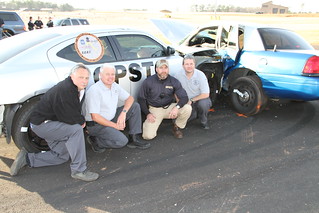
The crash was documented with onboard data recorders, video cameras and still photography for use in the accident reconstruction training programs that both GPSTC and GSP conduct. Officers from Cobb County Police Department, Macon Police Department and Monroe County Sheriff’s Office, and consultants from Forsyth and Marietta assisted with the crash and forensic mapping of the scene.
“Rarely do we get to calculate initial speeds, impact speeds and changes in velocity with the benefit of having that information available from on-board data recorders,” said GPSTC’s Traffic Section Manager Bruce Stanford as he explained how conducting the crash is important for training purposes.
“The video and evidence collected from this crash will be invaluable in the classroom because we’ll be able to walk students through the collision in slow motion, explaining how the vehicles involved in a crash acted on each other and why,” said GSP SCRT Master Trooper Truman Boyle. “By capturing this data during the crash, we can scientifically validate the formulas and methods that we use to teach.”
The crash was conducted using remote control operated cars and hydraulic systems designed by a team of GPSTC and GSP staff. In preparation for the crash, the development team conducted more than 40 tests to ensure the safety of the methods used to crash the vehicles.
“In the training we typically conduct here at GPSTC, we use after-impact photos and evidence, but rarely are we able to watch a crash in real time and then also frame by frame,” Stanford said. “This new methodology represents a huge advance in GPSTC’s ability to provide training that best replicates what officers will experience on the job.”
Stanford also explained how this first-ever crash test can be re-used to train hundreds of students without incurring additional cost. “Through the use of forensic mapping technology, our staff can place the collision we conducted today at any intersection on the GPSTC grounds in the future for students to reconstruct from start to finish, just as they will be required to do in the real world.”
For GPSTC and GSP instructors, this advanced technology means that evaluating a student’s ability to reconstruct an accident has become more accurate. “Normally, trainees are furnished with certain pieces of information for a classroom project,” said Stanford. “This new capability allows us to require students to obtain every piece of information required to accurately reconstruct an accident, and that allows us, as instructors, to identify and correct any deficiencies within the student or within the curriculum itself.”
“The implications behind this capability we’ve developed are incredible,” said GPSTC Executive Director Tim Bearden. “In the future, we can use this technology to reconstruct pedestrian and bicycle crashes, motorcycle crashes, as well as dozens of types of vehicle crashes; and we can do it all using resources we already have here in Georgia.
“Typically this type of testing is performed by consultants and it comes with a heavy price tag.” Bearden explained. “By developing a method for conducting these tests on our own campus, we will put better trained officers on the road and save the taxpayers of Georgia tens of thousands of dollars. In my book, that’s a win-win.”